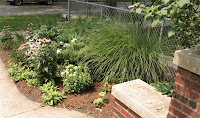
We went for a walk in the mountains and found what you'd expect: marmots, meadows, and lots and lots of lodgepole pines. But I didn't expect the wildflowers. It just seemed strange to find so many different kinds growing above the tree-line with very little water.
For instance...

This lunar pass was at 10-11,000' elevation and seems sparse without a good hard look at the ground...

These pink tufts are oval-leafed eriogonum and come in all sorts of colors in all sorts of zones.
The petals aren't petals, but sepals instead. Not sure what the exact difference is, but their tube-like quality lend them a nice sci-fi vibe, especially with the various lichens and whatnot.
In addition to the types of plants you'd expect to see in a very dry area at high elevations...

like this Anderson's thistle (which, according to the one book I have, was eaten by some Native Americans, raw or cooked)...

turning the corner, or endless switchback, could reveal a mini oasis with any spring. The yellow flowers are called seep-spring monkeyflower and the moss, well the moss was so...mossy. And if I ever move to the Pacific Northwest, a-moss gardening I will go.
This hiking trip we decided to limit our panoramic photography because it's really difficult to get a sense of the dizzying scale. The views one is privileged to experience just don't translate in a two dimensional snapshot.
So, we tried out lots of macro settings and close ups. I'm really happy with them because, oddly enough, they seem to detail the complexity of the place.
And the bugs looked cool too.


That fuzzy pea is the fruit of the large-leaf lupine, a beautiful blue delphinium-like plant. I'm not sure about either bug, but I'm telling myself the black bee is the Franklin bumblebee, a California native that's been MIA for two years.

After a few days we said goodbye to the heights and howls and headed back to the Midwest.
Returning from a trip is always a little hard, and the biodiversity of the back yard wasn't holding up too well against the mountains.
But then I saw a black swallowtail on a coneflower...

















































